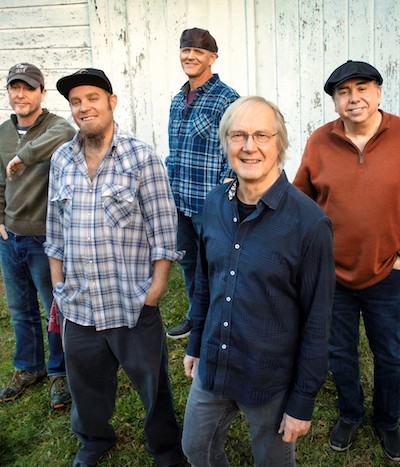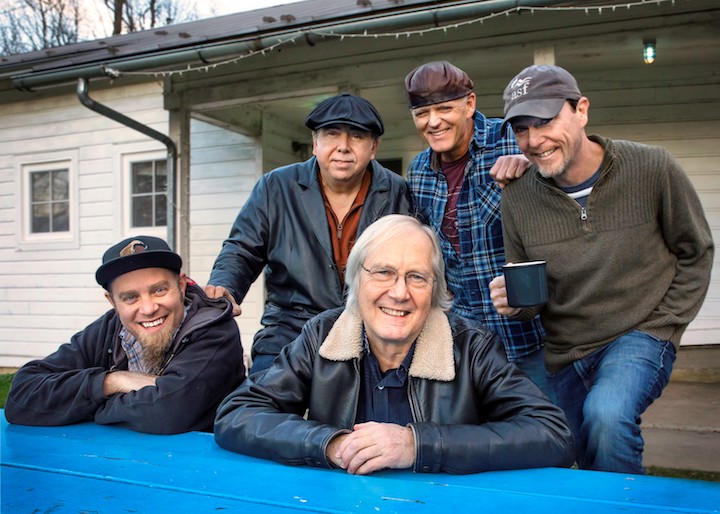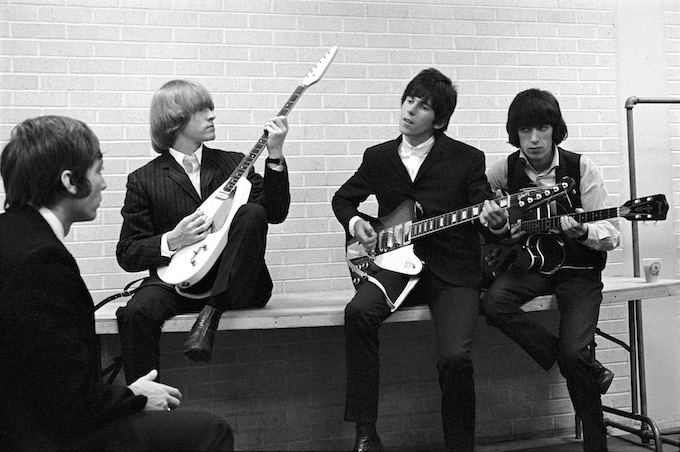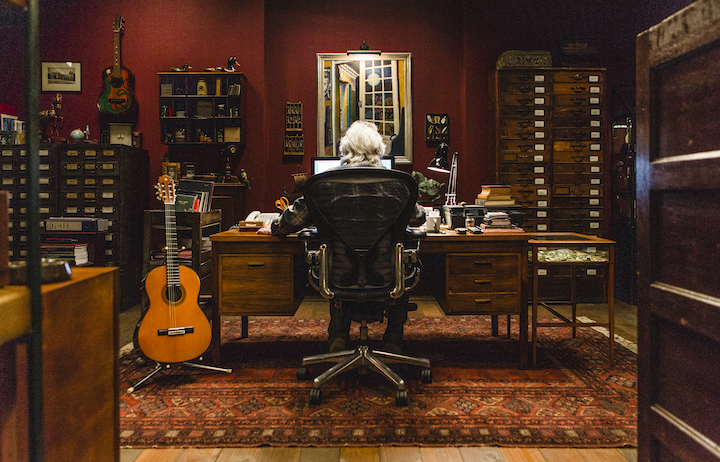
The Weight Band (left to right): Brian Mitchell, Michael Bram, Albert Rogers, Jim Weider (front), and Matt Zeiner. Photo by John Halpern/Courtesy of Jim Weider.
by Ray Dafrico
Contributing Writer
Heads up for fans of The Band, guitarist Jim Weider, former Atlanta resident and all around Kool Kat,
will be back in town for a show with The Weight Band at City Winery on Sunday Oct. 17 (Buy Tickets here)! ATLRetro contributing writer and fellow Kool Kat Ray Dafrico (Nightporters, Kathleen Turner Overdrive) interviewed Jim recently and got the scoop on Jim’s time in The Band, why he’s excited about The Weight Band’s Atlanta gig, and much more. Watch a teaser for the show here.
ATLRetro: Hi Jim, let me start by saying it’s a privilege to have a chance to ask you some questions on behalf of ATLRetro and especially since you are Fender Telecaster devotee as I am! I always felt the Telecaster was the working musician’s guitar. Am I correct?
Jim Weider: Absolutely! it’s a big plank of wood, that’s tough to play, tough to bend, but it’s got its own tone
ATLRetro: That’s how I feel, so I had to get that that question out of the way first since I am a guitar player. So how are you?
JW: I’m doing pretty good. Last night we played at Levon’s venue, Levon Helm Studios, so I’m just getting up and about. Looking forward to coming to Atlanta, I can tell you that.
ATLRetro: Cool, that sounds like it was a lot of fun. I’m sure you’ve told this story a million times, but for those not familiar with you or your background, let’s start at the beginning. If I’m correct, you saw The Band, that’s THE BAND at the Woodstock festival, and then 10 years or so later you ended up replacing Robbie Robertson as the guitar player? How exactly did that did that happen?
JW: Well it was, you know, I had slowly over the years met some of them. Some of them were living in Woodstock, or they all were living in Woodstock for a while. I had start playing with Levon Helm and his band when I moved back from Atlanta. I got into Levon Helm’s band and the All Stars, then we did some shows. Eventually in 1985, everybody moved back to Woodstock. Garth Hudson, Richard Manual, and Levon. Then Levon asked me to come on tour with them. We did the Crosby, Stills & Nash tour in ‘85, and I’ve was with them for 15 years. But it happened because of Levon.
 ATLRetro: Oh wow! That’s a great story! So what was it like playing alongside the likes of Levon, Rick Danko, Richard Manuel, and all those guys?
ATLRetro: Oh wow! That’s a great story! So what was it like playing alongside the likes of Levon, Rick Danko, Richard Manuel, and all those guys?
JW: It was just great. They’re real down-home fellas, you know. They were always about the music. When we would finish a show when I first joined, they would record it on a cassette. When we headed out to the next show, we would drive all night and listen to the show to try to improve it. They were always about the music. They were just a great bunch of guys, and we did a lot of laughing.
ATLRetro: Great, yeah, I’m a big fan. I’m currently reading the Robbie Robertson’s book [TESTIMONY] right now, and I just saw the recent documentary [ONCE WERE BROTHERS (1999)], so it’s good timing for me to talk about this stuff. So your current project is called The Weight Band. How did that come about and how long has that been going on?
JW: it’s been going on since when Levon passed in 2012. I got together with Garth Hudson, Jimmy Vivino and Byron Isaacs, who’s now in The Lumineers, but we went out did a couple of gigs and called it Songs of The Band. Then Garth went off and did his thing, and Vivino went back with Conan O’Brien, so I just said, “you know what? People are enjoying hearing this music again, why don’t I go out again and play some shows?” That’s how it kind of started. I ended up writing an album for the band which is WORLD GONE MAD and calling it The Weight Band. That was our first studio album. Since then we just made a new one also, which will probably come out next January. We have a live album out now, called ACOUSTIC LIVE AT BIG PINK AND LEVON HELM STUDIOS. That’s kind of how it began, and it just started growing into a totally original group. We still do classic songs of The Band and our own original tunes. We have a new keyboard player named Matt Zeiner, who was with Dickey Betts, so [we] throw in an Allman Brothers tune and some [Grateful] Dead stuff, but it’s been a blast.
 ATLRetro: Very cool. So you’re playing Atlanta at the City Winery on Sunday October 17. Tells us what we can expect at the show.
ATLRetro: Very cool. So you’re playing Atlanta at the City Winery on Sunday October 17. Tells us what we can expect at the show.
JW: Yeah, it’s an early show at [8 PM, doors 6:30 PM]? My old buddy from Atlanta, Tommy Talton, is going to open the show and do a short set, then we’re going to come on and we’ll bring him up. I used to play in Atlanta for many years in the late ’70s, and I had a band called Full Tilt. It was with Richard Bell from Janis Joplin‘s group, Wet Willie’s drummer T.K Lively, Stan Robertson on bass. So I have a lot of friends down there, and we’re gonna have a blast! I’m looking forward to hitting Atlanta again.
ATLRetro: Actually that was going to be my next question! You must have read my mind. I was doing my research and saw that you did a lot of session work here in Atlanta a while back?
JW: That’s awesome. Well, what first brought me to Atlanta was Axis Recording Studio. My buddy Robert Lee got me to come down as a songwriter that was involved with at that studio. I was on staff with Harvey Brooks on bass and Richard Bell. We all lived in Atlanta and recorded for people at the studio, and then at night I’d had a band, several bands really. One of them was with Jerome Olds, who’s a great singer, and then after that was Full Tilt. We used to play the Harvest Moon, Moonshadow Saloon for four sets a night, five nights a week, a month at each place. Man, that’s how you get tight!
ATLRetro: Yeah, I used to go to the Moonshadow. I met B.B. King there once. I was about 17, I think, and he was actually sitting backstage by himself. We talked for half an hour or so. He was such a nice guy, and he gave me his autograph. That was a cool club.
JW: Yeah, it really was. The Agora Ballroom? Those are the good old Atlanta days and I’m looking forward to coming down there. The band has got five vocalists and everybody sings. It’s the best harmony that I’ve been in since The Band. It’s a pretty amazing bunch of guys I got with me. We even cover some Dead tunes and our own originals from THE WORLD GONE MAD album. It’s gonna be a blast, with classics from The Band of course.

The Weight Band (left to right): Matt Zeiner, Michael Bram, Albert Rogers, Jim Weider (front), and Brian Mitchell. Photo by John Halpern/Courtesy of Jim Weider.
ATLRetro: I heard you jammed with Keith Richards and Scotty Moore. Those are two pretty heavyweight guitar players I must say! I’ve met Keith before, and he was exactly like I hoped he would be, so that made me really happy, but I didn’t get to jam or anything. How did that come about?
JW: I was producing Paul Burlison, the rockabilly guitarist, and at the same time we were cutting a track with the band for the ALL THE KING’S MEN album with Scott[y] Moore and DJ Fontana, and Keith was invited up as a guest to play with the band. So that’s how I that all happened you know, and so we cut a track and had a party.
ATLRetro Now that sounds like a lot of fun!
JW: It was!
ATLRetro: Speaking of Keith, do you use a lot of different or open tunings with The Weight songs or The Band’s songs?
JW: No, it’s pretty straightforward. If I’m playing slide, sometimes I’ll do an open E or open G, but yeah, not too much, just regular things for the most part.
ATLRetro: You were actually born in Woodstock, New York, correct?
JW: Yeah
 ATLRetro: What was it like growing up there?
ATLRetro: What was it like growing up there?
JW: It was nice. I mean it’s up in the country so you bring your fishing pool to school, then after school, you can go fishing in the Esopus River, which runs right along side it and also a reservoir’s there. There’s great music in Woodstock. You see, everybody lived here at that time, so you could see everybody jamming in the bars. When they weren’t on the road, they would be out jamming because they were all in their early 30s, late 20s, so they all wanted to play when they were off the road. Buzzy Feiten and Paul Butterfield, from the Butterfield Blues Band, they were all jamming at the clubs. Charles Mingus. Everybody would be coming up playing. Back then, music was everywhere, and people really supported music. I hope that happens in Atlanta these days .
ATLRetro: Yeah, it’s been hard, That was part of my my next question. With Covid, it must feel great to get out there and play after the lockdowns and the general chaos we’ve been living through the last four or five years, six years. How’s the tour been so far and are you out for a long time?
JW: No, we go on and off, you know. We go out for a week and then come back, then do a weekend here and there. We have a big Midwestern tour coming up in November, but we’re not really hitting it that hard. I mean it’s tough out there now with Covid. People who are vaccinated come out and, if you feel uncomfortable, wear a mask, you know, but as long as you’re vaccinated and you wear a mask, go out and enjoy live music and have a couple of drinks. And enjoy yourself!
ATL Retro: Exactly. I actually went and saw the The Monkees, or well, two of The Monkees, last night, and it was actually really good. I didn’t know what to expect, but it was is Mike Nesmith and Mickey Dolenz [The Monkees Farewell Tour] and I had a good time. I haven’t been out to see a band in like two years .
JW: All right! Well you gotta come out and catch us!
ATLRetro: Oh, yes, definitely, I will be there. Is there anything else you want to add?
JW: I’ll just say, you know, come out, come out, and have some fun. Don’t be afraid. We’re going to have a great time, and you’ll get to hear some new tunes, some Dead, some Allman Brothers, and I got a guy who played with The Allman Brothers, two of them now. Tommy Tulston is opening up the show. So come on out and have some fun on Sunday October 17!
ATLRetro: Excellent. Thanks, Jim. I want to thank you for taking the time to talk to ATLRetro. It was great to chat with you, and I’m looking forward to seeing the show!
Contributing Writer Ray Dafrico is a guitarist, singer/songwriter and founding member of The Nightporters and Kathleen Turner Overdrive. Check out his Kool Kat interview here.
















